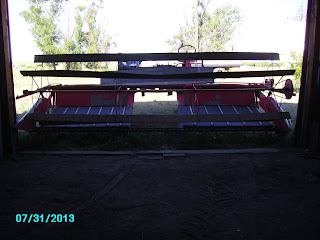Every occupation
has its share of jobs that are tedious but necessary. Here follows a couple of my least favorite
farm tasks.
The pile of chaff
you see clinging to the side of the combine is less than the tip of the ice
berg. It is easily dislodged with
compressed air (easier if you get to it before it rains and glues it to the
combine).
The ice berg in this case resides underneath
the operator’s platform. Here is the “harvest”
from that field:
The “harvester”
in this case is a combination of shop vac, compressed air, and a good old human
arm.
Before shop vac,
that job was done manually, one fistful at a time while kneeling or lying on
top of the feeder house. Not much fun. So why do it if it will only fill up again
next harvest? Moisture always
accumulates in the mulch and rusts the metal is one reason. Mice are a second reason. They find it a nice place to nest with lots
of material and even a food supply.
There are four
filters on top of the cab, two dry and two wet that have to be cleansed. The engine, its compartment and air filters
all have to be done, and the residue of grain in the bottom of the bin has to
be cleaned out. The bottom of the bin
wouldn’t be too bad if it weren’t for the unloading auger and the auger shield
over the auger. The auger flights are
sharp, and you are on hands and knees in the bin bottom. This year we had enough showers that there
was wheat growing in the bin bottom. It
hangs on to the metal pretty well. A
pancake turner and compressed air worked pretty well.
All in all, it’s about
a day’s job to remove the header, clean and stow it in the shed, clean the main
machine and stow it.
Here it is where
it will spend the next eleven months.
Its roommate is a fifties version that hasn’t been out of the shed in
twenty years. Know anybody who wants a
60-year-old combine?
Once it’s in place, drain the oil, change the filter, fill
with new oil, and you’re good to go next year.
A little higher on the un-fun list is
putting the windrower away. It has to come out to get the combine out. The
header is 15’ 11 3/4” and the door is 16’.
Everything is home
now. On to unlovable job #2—bindweed eradication. Here is a patch that has straggled on for 20
years:
Those cute
little white flowers are bindweed blossoms.
The weed may take a year or two off, but it then springs back. The seed can lay dormant for many years and
then sprout and go. Banvel and Torodon
to the rescue. You have to have a
license to buy and use Torodon, a restricted-use pesticide. The license costs $100 and a few hours of
studying and test-taking, renewable every two years. I use a hand sprayer, about three gallons of
spray on this spot. Of course the sprayer
has to be cleaned, and then, me, too. (Do you suppose it’s cleaning things I
don’t like?)
Those jobs are all
done and it’s back to farming.
I got interrupted
by rain! Two thirds of an inch of gentle
shower over a few hours! We missed the
ugly tornadic cloud about six miles north.
It chased me out of the field.












No comments:
Post a Comment